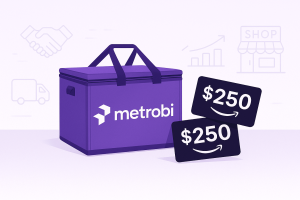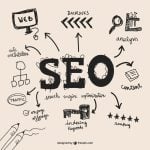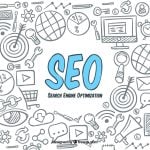SEO is not about tricking search engines in 2025. Many businesses still waste time with outdated SEO tactics that don’t work and fail to address critical technical SEO issues like broken links or missing relevant backlinks.
Here’s what works: A well-planned SEO campaign focused on creating value for real people. The kind that generates more organic traffic and makes Google think, “Yes, this is exactly what users are looking for.” Incorporating keyword ideas with high search volume and tracking key metrics are vital to driving meaningful SEO results.
The difference between a winning SEO campaign and failure often comes down to understanding modern SEO campaign management. Not the surface-level stuff you find in most articles but strategic planning, execution, and continuous monitoring of SEO performance and keyword rankings.
Think About This: 68% of all online experiences begin with a search engine.
Your potential customers are actively searching for particular keywords related to your offerings. The question is: Will they find you or your competitors? Ensuring strong inbound links, maintaining a clean SEO audit, and optimizing for organic search traffic is critical to your success.
In this comprehensive guide, we’ll show you the best SEO tools and strategies that work in 2025. You’ll learn exactly how to:
Plan an effective SEO campaign from start to finish
Choose the right SEO metrics to track your success
Apply advanced techniques that most businesses miss
Avoid common mistakes that can hurt your rankings
Whether you’re an eCommerce client, a business owner using Google Ads, or an SEO agency, you’ll discover actionable steps to outperform your competition. For businesses aiming to enhance their logistics, leveraging a reliable delivery service can significantly improve operational efficiency and customer satisfaction. By exploring high-quality options, like a trustworthy courier service in Sacramento, companies can ensure prompt delivery and reliability, which enhances their overall service quality.
Ready to learn how to make search engines work for your business? Let’s begin with the foundations.
Metrobi drivers are rated 4.97/5
Trusted by local businesses for:
- Background-checked professionals
- Specialized in business deliveries
- Same drivers for consistency
- 4.97/5 average delivery rating
What is SEO Campaign Management?
SEO campaign management aims to boost search rankings and web traffic.
Involves steps like planning, executing, and monitoring SEO strategies.
Key elements include keyword research, content optimization, and link building.
Examples of Effective SEO Campaigns
Effective SEO campaigns can transform a business’s online presence. For a case study, consider an e-commerce site that boosted traffic by identifying high-performing keywords relevant to their products. They performed thorough keyword research, used those keywords in their website content, and improved their internal linking structure. As a result, they saw a 150% increase in organic traffic over six months. This shows how targeted SEO efforts can drive significant results. To further enhance your business’s success, consider optimizing logistics with local services. For efficient delivery operations, hiring experienced couriers can vastly improve customer satisfaction and operational efficiency. Discover more about reliable Austin couriers that can meet your delivery needs.
To take your logistics to the next level in the Baltimore area, look into our top-tier Baltimore same-day courier service. This service will not only streamline your deliveries but also enhance your overall customer satisfaction by ensuring prompt and reliable order fulfillment.
Another example is a local business that improved its search ranking through local SEO strategies, like optimizing its Google My Business listing and encouraging customer reviews. They focused on specific local keywords and ensured all online mentions were accurate and consistent. The outcome was a 75% increase in local search visibility and a boost in foot traffic. This emphasizes that even small businesses can make a big impact with the right SEO strategies. By employing effective strategies for managing local SEO, businesses can significantly enhance their online presence and boost visibility in local search results. Local SEO is vital for any company looking to attract customers from their geographic area. For a deeper dive into how to implement these strategies, check out a detailed guide on effective local SEO tactics.
An effective SEO strategy not only improves rankings but can also significantly increase sales for businesses in 2025. Adopting the right techniques tailored to your specific audience is crucial. Ensuring strong keyword alignment and optimizing for emerging trends can propel your business. For further insights, explore this comprehensive guide on how to improve your rankings and drive sales through a smart SEO strategy.
Importance of Ranking: 95% of search traffic goes to the first page of search results, highlighting the necessity of ranking high.
Types of SEO Strategies
SEO strategies vary based on business needs and goals. There’s technical SEO, which involves site structure and code optimization. This helps search engines better understand your content. Then there’s on-page SEO, which focuses on elements within your website, like content and meta tags. Off-page SEO involves external factors, such as backlinks from other sites.
Industries require tailored SEO strategies. For instance, a fashion e-commerce site might prioritize product page optimization, while a tech blog focuses on content depth and keyword usage. Comparing different approaches helps in choosing the most effective strategy. Every industry has unique demands, making it essential to align strategies with specific business goals.
On-Page SEO Techniques
On-page SEO involves optimizing individual pages on your website. This includes using specific keywords effectively and refining page content to meet searcher intent. As Rand Fishkin noted, matching keywords to intent is crucial. Meta tags and descriptions also play a significant role; they help search engines understand and display your content better. Using clear, concise, and relevant tags ensures that your pages are attractive to both search engines and users.
Additionally, high-quality content is key. It must be valuable to readers, ensuring engagement and reducing bounce rates. By addressing common issues or questions within your industry, you can become a go-to resource, improving both rankings and user trust.
Off-Page SEO Strategies
Off-page SEO focuses on actions taken outside your website to impact your rankings. Building high-quality backlinks is a core element. Backlinks signal to search engines that your site is reputable and that others find your content valuable. The goal is not to make links appear natural but to ensure they are natural, as Matt Cutts suggests.
Most Web Pages Lack Backlinks: 66.31% of web pages have zero backlinks, underscoring the need for effective link-building strategies.
Social media also enhances off-page SEO. Sharing content on platforms increases visibility and potential backlinks. A robust social presence can drive more traffic to your site. Participating in online communities and discussions can further establish authority in your field, indirectly boosting your SEO. Properly leveraging these strategies creates a strong off-site profile, vital for long-term SEO success. To achieve the best results with off-page SEO, one can do targeted link-building outreach to secure high-quality backlinks and improve search rankings.
Benefits of Mastering SEO Campaign Management
Increased Organic Traffic
Organic search is the backbone of most website traffic. It brings users who are actively searching for your services or products, leading to higher engagement. Unlike paid ads, which rely on budgetary constraints, organic search provides sustained traffic that doesn’t disappear when ad spending ends. This means a steady stream of visitors who are more likely to convert. Higher traffic directly correlates with higher visibility, thus enhancing brand recognition.
Majority of Website Traffic: Organic search is responsible for 53.3% of all website traffic, showing its crucial role.
Conversion rates from organic traffic tend to be more significant than paid search. With search algorithms prioritizing content relevancy and user satisfaction, sites offering valuable and targeted content see more visitors converting to customers. “No matter how niche or mainstream your market is, great content remains a significant focus for SEO,” emphasizes Kristopher Jones, Founder of LSEO. Investing in organic search creates opportunities for ongoing sales and brand loyalty.
Improved ROI
Compared to traditional advertising methods, SEO offers more bang for your buck. It creates long-lasting impacts that extend beyond short-term campaigns.
SEO vs. Email Marketing: SEO’s average return on investment stands at an impressive 22:1, proving its efficiency. Email marketing might offer higher ROI at 42:1, but it's a more intrusive approach, with limits in reach compared to SEO.
Crafting an effective SEO strategy means understanding your audience and what resonates with them. This deep engagement ensures that content reaches the right people at the right time. Unlike other forms of marketing that can feel like shouting into the void, SEO targets consumer intent, aligning nicely with marketing goals. “You can’t optimize what you don’t measure,” according to Moz, underscores the need for monitoring and adapting strategies. Focusing on metrics fine-tunes efforts and maximizes returns.
Enhanced Brand Authority and Visibility
SEO does wonders for brand visibility. Dominating search results not only drives visitors but positions your brand as an expert. While ads can achieve similar immediate effects, they fail in comparison over the long term where SEO shines. Users tend to trust organic results more than ads, thus enhancing credibility. As Surfer SEO notes, “SEO improves brand visibility and allows you to present your brand as an expert in the field.”
User Trust in Organic Search: A compelling statistic that highlights users' trust in organic search results over paid ads is that 70% of all searchers ignore paid ads and focus on organic results only.
Over time, being at the top of search results earns trust. The more your content is seen and shared, the greater your authority becomes. Consistency in high-quality content generation not only solidifies your position in search results but amplifies domain authority. The long-term benefits here outweigh the fleeting visibility generated by quick-burn ad campaigns.
Lower Cost per Acquisition (CPA)
SEO’s cost-effectiveness eclipses many digital marketing avenues. Unlike pay-per-click where you pay for each interaction, SEO builds momentum that lasts without ongoing cost. It’s a one-time investment that pays dividends by decreasing CPA.
Conversion Rate Comparison: SEO boasts the highest inbound conversion rate at 14.6%, compared to a mere 1.7% for outbound methods.
A focus on SEO means nurturing natural dofollow links and driving organic traffic without relying on paid promotions. This means that efforts are not only cost-effective but sustainable over time. Eventually, a robust SEO strategy leads to leads and sales without the continuous financial outlay required for paid approaches.
Long-Term Sustainability and Growth
SEO is a long-term strategy. Once a company ranks well, maintaining that position requires ongoing effort, but the hardest part is already achieved. “SEO is a journey, not a destination,” says Danny Sullivan, which sums up the ethos well. Unlike trends in online marketing which can be erratic, SEO establishes a solid base that allows for steady growth over the years.
As Google continues to refine its algorithms, businesses that keep pace see even more rewards. By constantly updating and improving their site’s SEO, they ensure sustainability and resilience against changes. This adaptability pays off as smaller changes generate compound interest in terms of traffic and growth. Consult resources by thought leaders like Rand Fishkin’s “Lost and Founder” or “Ultimate Guide to Link Building” by Eric Ward for deeper insights into long-term SEO planning.
SEO is indispensable for organizations seeking stable and perpetual growth. As its strategies evolve, mastering SEO campaign management ensures adaptation to changes in digital marketing landscapes.
How Does SEO Generate Online Traffic for a Business?
Google holds over 91.55% of the market share among search engines.
53% of all website traffic comes from organic searches.
Quality content improves authority and search visibility.
Explanation of Search Engine Algorithms
Search engine algorithms play a crucial role in directing online traffic. Understanding how they work can help businesses optimize their content and improve search rankings. Algorithms are designed to crawl and index web pages, evaluating them based on factors such as keyword usage, content quality, and engagement metrics. Factors like content relevancy and authority heavily influence rankings.
Impact of Ranking Improvement: A one-spot increase in rankings can boost click-through rates (CTR) by 30.8%.
Search engines prioritize sites with high-quality, authoritative content, which speaks to user queries effectively. Algorithms also value user experience, including page speed and mobile-friendliness.
Mobile-First Indexing: The increasing trend of mobile usage, with 63.38% of online traffic originating from mobile devices, makes mobile optimization essential for SEO.
For deeper understanding, books like “The Art of SEO: Mastering Search Engine Optimization” provide comprehensive insights into the technical workings of algorithms. Engaging with these resources can equip marketers with the knowledge to adapt and stay ahead of SEO changes.
Role of Content Relevancy and Authority in Rankings
Content relevancy and authority are pivotal to driving traffic. They determine how search engines rank web pages. Content must align with user intent and answer specific queries to be considered relevant. Authority, on the other hand, is often established through the E-A-T framework, which stands for Expertise, Authoritativeness, and Trustworthiness. This framework guides content creation, ensuring it is backed by credible sources and experts, fostering trust with search engines.
High-quality content that attracts backlinks improves a site’s authority. Backlinks serve as endorsements from credible sources, further boosting search visibility. The quality of these links significantly impacts rankings more than sheer volume. For businesses, investing in creating engaging, informative, and expert-backed content can lead to improved rankings and increased organic traffic. Reading “SEO 2025: Mastering Search Engine Optimization Techniques for the Modern Era” can provide strategies on maintaining relevancy and authority in the dynamic SEO landscape.
How SEO Attracts Customers and Boosts Visibility
SEO attracts customers by ensuring businesses appear prominently in search results, thus increasing visibility. Targeting local keywords can drive traffic from users actively searching for local services or products.
SEO's Critical Role in Website Traffic: With 53% of website traffic derived from organic searches, optimizing for search engines is essential for reaching a wider audience.
Backlinks and high-quality content not only improve rankings but also enhance brand visibility. As more users encounter a brand through organic search results, brand recognition and credibility grow. This visibility reinforces trust and interest among potential customers. For a detailed exploration of how to effectively leverage SEO for customer attraction, “Local SEO Secrets: Proven Strategies” offers in-depth tactics for local engagement.
How SEO Increases Traffic and Business Impact
The impact of SEO on traffic and business metrics is substantial. SEO’s cost-effectiveness makes it an appealing strategy. It compares favorably to traditional advertising methods, offering sustainable returns on investment over time.
SEO also plays a role in long-term sustainability and growth. As users continue to trust and rely on search engines for answers, appearing in top results becomes increasingly valuable. This consistent visibility translates into ongoing traffic gains without the need for constant advertising spend. For further reading, “SEO 2025: Strategies for Sustained Growth” delves into the evolving SEO techniques that businesses can use to maximize traffic growth.
Conclusion and Recommendations for Continued Learning
SEO isn’t just about search rankings. It is an integral part of a business strategy that drives traffic and ensures sustained growth. As search algorithms evolve, staying informed is key to maintaining and improving search visibility. One may wish to explore resources such as the online course “Advanced SEO Techniques: Beyond the Basics” for interactive learning experiences.
In summary, SEO generates online traffic by leveraging algorithms, content relevancy, authority, and customer engagement. It boosts visibility, drives significant traffic, and enhances business impact. For those interested in expanding their expertise, exploring the recommended books and courses can offer deeper insights into optimizing strategies for future SEO success.
Advanced SEO Analytics Tools for Campaign Management
Learn to track and measure SEO success.
Refine strategies with advanced analytics insights.
Boost campaign effectiveness using detailed data.
Google Analytics and Google Search Console for SEO Insights
Google's Dominance in Search: 91.55% of the total search engine market share is held by Google, making it crucial for businesses to optimize for this platform.
Google Analytics is essential for diving into keyword data. By linking it with Google Search Console, you unlock keyword tracking capabilities. This feature highlights which keywords bring visitors to your site. It goes beyond clicks, capturing impressions and click-through rates as well. While it helps identify keyword effectiveness, the context supports data-driven decisions.
Understanding traffic sources and user behavior has never been easier. Google Analytics offers insights into how users find your site and interact with it. By examining organic search performance, you get a snapshot of how your content pulls in an audience. For professionals, setting up specific goals like purchases can translate complex data into actionable insights. This creates a direct line between SEO strategies, website interaction, and conversion success.
Delve into books like Web Analytics 2.0 by Avinash Kaushik for a deep dive into analytics. He offers readers tools for translating data into insights that spur actionable change. On a broader scope, you might explore courses on platforms like Noble Desktop or resources like Analytify’s Keyword Report Synopsis to advance your understanding.
SEMrush for Comprehensive Analysis
SEMrush stands out for its competitive analysis capabilities. The platform identifies SEO opportunities and potential gaps that might go unnoticed. With features that shed light on competitor strategies, it acts as a beacon for what’s working for others in your niche. However, while SEMrush offers robust data, the reliance on a single tool could be limiting.
Its comprehensive datasets let you spot SEO gaps and opportunities effectively. The context created by SEMrush allows you to compare competitor performance and align your strategy with leading trends.
Books such as SEO 2023 by Adam Clarke provide context for using tools like SEMrush effectively. This reading also bridges the gap between knowing what tools offer and how to practically apply the insights gained. Dive into SEMrush’s resources for direct knowledge from the source.
Importance of Analytics in Refining Strategies
Analytics tackle the subtle art of strategy refinement. Tools like Google Analytics allow for a nuanced understanding of how users engage with your content. They serve as a guide for tweaks and adjustments to campaigns. As SEO is not static due to algorithm shifts, analytics help keep you agile amidst constant updates.
Integrating data across different SEO tools creates a fuller picture. When Google Analytics data merges with other platforms, the depth of insight increases. This depth helps with evaluating SEO success, ensuring you grasp how well your strategies are working. But there’s a potential downside to over-relying on disparate data sources without a cohesive review.
For further exploration, Data Science for Business by Foster Provost provides a foundation for mastering data-driven decisions in SEO. With the data available from analytics tools, it’s essential to refine strategies through a structured approach, making sense of the myriad points available.
Tools for Tracking and Measuring SEO Success
When tracking SEO success, the choice of tools can define accuracy and effectiveness. Google Analytics provides comprehensive insights but consider complementing it with other tools for specialized results. Tools like Ahrefs or Moz offer different angles on ranking and backlink analysis.
The key lies in choosing a mix of tools that cater to the various aspects of SEO, from keyword tracking to backlink profiling. Each tool adds a layer to your understanding, closing gaps and fortifying strengths. The downside of juggling multiple platforms is data fragmentation, making it essential to plan data integration strategies.
To take this further, Mastering Attribution in Analytics Tools by Jonathan Greene offers techniques to understand multi-touch attribution in analytics. The importance of a well-rounded toolkit can’t be understated, with each component reinforcing your overarching campaign efforts.
Reflections and Further Exploration
Understanding and implementing analytics effectively requires a journey. It transcends beyond knowing what data points mean, demanding an application of insights for campaign improvement. The difference comes from analyzing data contextually to support long-term growth in web traffic and user engagement.
Consider discussing insights and strategies with peers or attending SEO-focused webinars. Communities like Moz or discussions on platforms like Reddit offer peer reviews and experiences on the best applications of analytics tools. This broadens understanding and encourages innovative strategies.
Continue exploring the integration and application of analytics in SEO, knowing these tools serve as your compass in a continuously evolving digital landscape. This preparation leads to more structured and informed future campaigns.
Effective Search Engine Marketing Strategies
Optimize results by integrating SEO with paid search.
Market and keyword analysis strengthens strategy.
Improves visibility, credibility, and conversions.
Combining SEO and Paid Search for Optimal Results
Integrating SEO strategies with paid search offers a dual approach that enhances overall marketing efforts. When combined, these strategies can bring about impressive traffic and conversion outcomes. For instance, leveraging both organic and paid search results increases visibility and trust. Users encounter the same brand in both segments of search results, reinforcing brand familiarity.
Organic Search Dominance: The trust of organic search results is evident, as 42.25% of search clicks come from organic results.
Investing equally in organic and paid strategies is fundamental for a comprehensive digital marketing approach. While organic search drives the vast majority of website traffic, it typically receives only a small fraction of marketing investments – creating a notable imbalance in resource allocation. A more balanced investment strategy between organic and paid channels could help optimize overall marketing performance. When organizations effectively integrate their SEO and paid search efforts, the synergistic effect accounts for a significant portion of both traffic and conversions. The lesson is clear: taking a balanced approach to organic and paid strategies maximizes both exposure and credibility in the digital landscape.
Top ROI Channel for Marketers: 49% of marketers report that organic search provides the highest return on investment (ROI) compared to other channels.
Techniques for Market and Keyword Analysis
Understanding your audience begins with in-depth market and keyword analysis. Identifying high-volume keywords the target audience uses is crucial. Looking for opportunities in SEO campaigns without this step is challenging. Beyond just searching for keywords, understanding search intent and context is essential. Tools like SEMrush and Ahrefs provide insights into market trends and competition dynamics, making keyword identification more strategic.
A key part of keyword strategy is focusing on long-tail keywords. They often come with higher conversion rates than short-tail words. These keywords cater to specific search intents, target niche markets, and face less competition. High-performing keywords should be optimized for content and used strategically in PPC campaigns to maximize reach without excessive costs.
Dominance of Long-Tail Keywords: Long-tail keywords make up 70% of all web searches.
Comprehensive Keyword Research
Tools for Finding High-Volume Keywords
Keyword research tools are pivotal in discovering untapped keyword opportunities. Google Keyword Planner, SEMrush, and Moz’s Keyword Explorer identify high-volume and competitive keywords. These tools provide insights into keyword difficulty, search volume, and trends. A strategic approach involves balancing high-volume keywords and specific long-tail keywords.
Effective keyword research includes competitor analysis. SpyFu and Ahrefs allow marketers to enter competitors’ sites to analyze their keywords. This provides an overview of competitors’ strengths and weaknesses. Additionally, integrating insights from these platforms with data from Google Analytics reveals which keywords drive the most traffic, enabling fine-tuning of both SEO and PPC efforts.
Importance of Long-Tail Keywords for Niche Targeting
Long-tail keywords should not be overlooked as they play a significant role in targeting niche audiences. These keywords are often more descriptive, meeting the specific needs of searchers. For example, instead of “running shoes,” “best running shoes for marathon training” provides a direct focus. Incorporating long-tail keywords into your content can attract a more relevant audience, increasing engagement and conversion rates.
Consider reading “The Long Tail” by Chris Anderson to understand the impact of niche markets. It provides insights into how targeting specific, lesser-known keywords can drive significant traffic. Additionally, exploring forums and niche community discussions can offer real-world examples of keyword usage, enriching your keyword strategy.
By weaving together these techniques, integrating SEO with paid strategies gains a competitive edge. This results in increased web traffic, conversions, and enduring business growth.
Increasing Website Traffic with SEO Tips
-
Use regular updates and mobile optimization to boost visits.
-
Small changes can make a big impact on search rankings.
-
Stay on top of trends to maintain SEO effectiveness.
Tip #1: Regular Content Updates
Keeping your content up to date isn’t just productive; it’s necessary for SEO success. Search engines prioritize fresh content, making it a critical strategy for improving rankings and drawing consistent traffic. A website filled with updated, relevant content is more likely to attract returning visitors, as users anticipate new insights and information. Therefore, businesses should commit to a regular schedule of publishing new blog posts, updating existing pages, and ensuring their content aligns with search engine updates.
Maintaining a dynamic content strategy also means adapting content to reflect the latest industry trends and changes. Referencing books like Content Inc. by Joe Pulizzi can offer guidance on how to build an audience through strategic content marketing. Additionally, regular updates give opportunities to refine keyword use, create more engaging headlines, and use newer formats like video or interactive content to capture user attention more effectively. All these contribute to better engagement metrics, such as reduced bounce rates and increased time on site.
While constantly producing new content is beneficial, it’s important to balance quality over quantity. Prioritize detailed, value-driven articles that answer user questions thoroughly. Consider investing time in understanding what content performs best through tools like Google Analytics, which can provide data on user behavior and content performance.
Tip #2: Optimize for Mobile
In today’s digital age, mobile optimization is indispensable. With over half of global internet traffic coming from mobile devices, ensuring a mobile-friendly website design is non-negotiable. Google’s mobile-first indexing means that the mobile version of your site is what they primarily use to rank your pages. A seamless mobile experience can enhance SEO rankings, directly influencing your site’s visibility.
Building a mobile-friendly design involves several key elements. First, ensure your site is responsive, adapting to different screen sizes without losing functionality or aesthetic value. Tools like Google’s Mobile-Friendly Test can help verify this. Secondly, loading speed is critical. Compress images and streamline code to ensure quick loading times, as slow performance negatively impacts user experience and SEO rankings.
Additionally, consider user navigation. Streamline the journey to find information easily on smaller screens. The Book Mobile Design Pattern Gallery by Theresa Neil offers excellent insights into effective design patterns that promote an intuitive mobile experience. Balancing aesthetic appeal with functionality is pivotal in retaining mobile visitors and preventing high bounce rates.
What is the Best Approach for My Business?
A one-size-fits-all approach does not work in SEO. Tailoring your strategy based on your company size, industry context, and specific goals is essential for success. Small businesses may focus more on local SEO to capture regional traffic, whereas larger corporations might prioritize an international strategy. Industry standards and trends should guide strategy formulation, as some sectors might be more competitive in SEO than others.
Leverage data to inform your strategy. If you’re in the e-commerce space, for instance, your focus might be more on product page optimization. Consult studies like the SEO E-commerce Guide by Shotzr to find specific strategies that work well in this niche. Explore resources like SEO 2023 by Adam Clarke for up-to-date techniques and perspectives.
Understanding your competition and employing competitive analysis can also yield insights. Use tools like SEMrush to gauge competitor behavior and uncover gaps in your strategy. Stay informed about new methods and continue learning. Engaging with industry webinars, online courses, or SEO-focused communities can provide valuable insights and feedback. This adaptive learning and application mindset will help refine and maximize the impact of your SEO initiatives over time.
Conclusion
SEO campaign management success comes from small, steady steps. We looked at the key parts: keyword research, content quality, and link building. These are foundational SEO ranking factors that matter more than quick tricks for improving your website’s search engine rankings.
By now, you have practical tools to build a successful SEO campaign. Google Analytics shows what works, while SEMrush helps track progress and identify relevant keywords. But tools alone won’t get results—it’s how you use them that counts.
Start with one technique today. Maybe it’s fixing your meta descriptions, making your site mobile-friendly, or incorporating informational and transactional keywords into your content. Build from there. Good SEO takes time, but each small win contributes to a more effective SEO campaign.
Remember this: SEO isn’t just about climbing search engine results pages. It’s about connecting with real people who need what you offer. Focus on giving value through good content and target keywords naturally. The traffic will follow.
Think of your SEO work as planting seeds. Some will grow fast, others slow. But with care and attention, your garden of organic traffic will bloom.
Keep learning. Keep testing. The search landscape changes, but solid SEO principles stay the same. Your next steps are clear: pick one tip from this guide, implement it this week, and track your results.
Stay patient. Stay focused. Your business growth is worth the effort.














